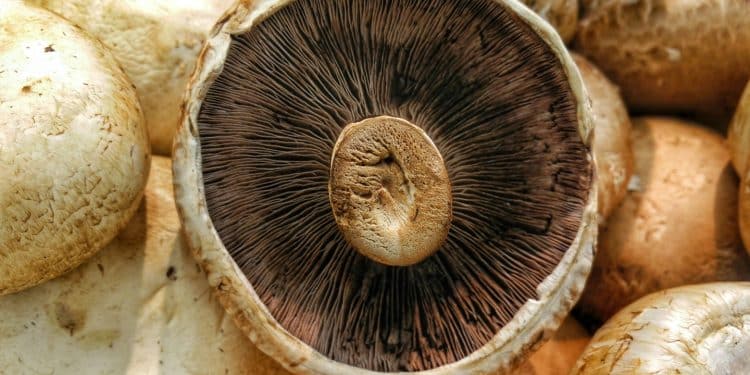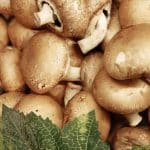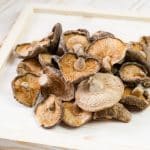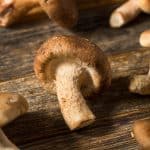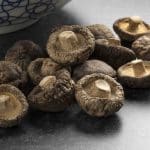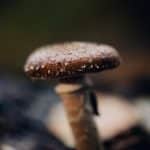So are shiitake mushroom stems poisonous? No, they are not poisonous. That is just a myth, but general the Shiitake caps are used in recipes only, and the stems are discarded. Try using these stems in soups and stocks, rather than simply throwing them out if you want to get creative. But you do not need to worry about them being poisonous by any means.
You can find our favorite supplements containing Shiitake Mushrooms on the following page of our website to learn more.
Best Shiitake Mushroom Supplements
But no doubt, a home cook would do well to ask which parts of mushrooms are edible before trying. Shiitake mushrooms have large, dark-brown umbrella-like caps, and relatively thin, creamy-colored stalks, making it easier to recognize when they are fresh. Compared with crimini or white button mushrooms, these mushrooms are slightly more expensive per pound, but the results are worth the extra cost. Shiitake mushrooms, particularly fresh varieties, are a great source of both iron and protein.
Eating them can also help lower cholesterol, boost immune system health, and even combat certain types of cancer. Sautes, risottos, soups, and others all benefit from the addition of mushrooms due to their meaty texture and earthy flavors. Shiitakes are best enjoyed when they are sliced thickly or halved, not chopped, due to their meaty taste. The stalks of Shiitake mushrooms are not edible as they are too stringy, but are still very flavorful.
Only a handful of shiitake stems are needed to add an earthy taste and a strong aroma to the soup. Using stems in vegetable-based, broth-based soups is a tasty way to use them. To make picking mushrooms easier, wrap the stems in cheesecloth as in a bouquet garni, unless straining your soup. Frozen mushroom stems have a limitless shelf life.
Copper, a mineral that helps keep your blood vessels, bones, and immune system healthy, is plentiful in Shiitake mushrooms. About 72% of your needed daily intake comes from 1/2 cup of shiitake mushrooms. Ergothioneine, the chemical found in shiitake mushrooms, helps lower cholesterol.
They also contain the anti-inflammatory beta-glucan, which helps prevent cholesterol absorption in the gut. They contain lentinan and other beta-glucan polysaccharides, like the ones found in Shiitake mushrooms. These substances protect your cells from damage, boost your immune system, and boost white blood cell production to combat germs. Polysaccharides are anti-inflammatory compounds, and also provide energy.
Mushroom stems, on the whole, are fine to eat. However, with the variety of different species of edible mushrooms available, the stem has grown just as delicious as the cap.
The mushrooms, however, are just that, mushrooms. Most of what we know about these mushrooms is that they are spongy, they have a stem and crown, and underneath, there are gills. While not every mushroom has that look, most of the edible mushrooms do.
In cooking, mushrooms can be used either as a meat or as a vegetable. Vegans often use mushrooms instead of meat in order to add bulk, texture, and flavor to vegetables. Most supermarkets and shops will carry fresh mushrooms.
The best way to know about some of these foods is to ask the salesperson what they are called, and usually prepare them, if you do not know. White buttons are an excellent starting point when it comes to getting acquainted with fresh mushrooms. They taste bland, almost like they are mild. As they cook, they pick up flavors from whatever they are in contact with.
In terms of texture, a shiitake is like a white button mushroom, but they have more of a robust flavor. Therefore, they can be prepared just like white button mushrooms. Whether you are stir-frying them, or cooking them longer, Shiitake mushrooms are up for the challenge. One reader reported that the shiitake stems could be cooked, sliced, and added to Spring Rolls and Dumpling Fillings rather than removed and discarded.
Are Shiitake Stems Poisonous?
It is a common myth that the toxic contents in shiitake mushrooms stems are why they are discarded. Do not get alarmed; both the fibrous stems and soft caps of this fungi are edible. The stalks of shiitake mushrooms are fine to eat.
Many fungi enthusiasts asked us about this.
Mushroom stems are different from each other, both in flavor and in their consumption convenience. If you are thinking of the way that mushrooms stems are eaten, then the King Trumpet Mushroom, aka King Oyster Mushroom, is one to go for. The stem makes up the majority of the structure of this mushroom, with just a small cap at the top. You can eat both the king trumpet mushrooms stem and cap, both are delicious. Even cooked, the stem retains a certain toughness, and takes on a taste similar to that of whatever you are cooking with.
Mushroom cell walls contain chitin, a fibrous material made up of carbohydrates. Humans have a hard time digesting chitin; thus, a cell wall form of chitin makes it hard for humans to take advantage of beneficial nutrients in mushrooms when they are eaten raw.
The stem is the most desired component; it is less desired by others.
It is easier for you to digest and absorb nutritional elements from mushrooms, as the chitin barrier breaks down during cooking.
Other edible mushroom stems
You can eat button mushrooms stems, along with other varieties like Portobello and Cicii. The flavors and tenderness of these mushrooms are found most prominently on the caps, whereas the stems may have some woody flavors. The stems and caps of the enoki mushrooms are edible as well. Enokis form a cluster with several dozen stalks, each one having a small, white cap sticking out from its end.
In addition to the oyster mushrooms, morels are an excellent choice for those looking to eat all the mushrooms. It is possible to eat morel stalks, but they need to be cooked first, as mushrooms contain toxic elements which will degrade if heated.
What Happens If You Eat Shiitake Mushroom Stems?
There is some good news, however: You can incorporate them into meals to reduce waste and still get a nutrient boost. This is true if you are cooking with cultured mushrooms. The nutrition profile and contents of edible mushrooms may offer a broad spectrum of essential nutrients.
Using stems not only saves you money, it provides a side dish to the table. Just keep in mind that not all the stems are edible or offer a lot of flavor, so it is pointless to keep them around. Mushrooms such as Portobello, Crabapple, Chanterelle, Porcini, or White Button Mushrooms, on the other hand, do have nice-looking stems you can eat. Mushrooms are rich in vitamins, minerals, proteins, and antioxidants, all of which are good for your health.
However, free radicals in your body, which are created by internal activities such as metabolism, may cause oxidative stress if they accumulate in high enough concentrations. While most species of mushrooms are safe for consumption, you need to use caution when eating wild mushrooms. Toxins and heavy metals in wild ones can be deadly because of excessive concentrations.
Learn more:
